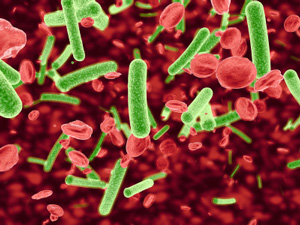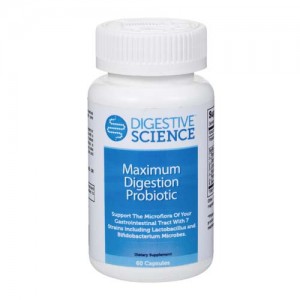 As Dustin Hoffman says in the 1995 thriller Outbreak, “You’ve got to love its simplicity. It’s one billionth our size and it’s beating us.”
As Dustin Hoffman says in the 1995 thriller Outbreak, “You’ve got to love its simplicity. It’s one billionth our size and it’s beating us.”
Then Kevin Spacey says, “What do you want to do, take it to dinner?”, to which Hoffman replies, “No, kill it.”
OK, technically they weren’t talking about clostridium difficile, better known as C. diff, but they make a good point; that a microscopic organism can slap you around six ways from Sunday if it’s of the nastier variety. And when your natural balance of microflora gets disturbed, and C Difficile gets out of hand, that’s exactly what it does, with diarrhea being its best-known symptom, that can range from mild to deadly.
About C Diff
You may need your calculator for this one: the intestines host about 100 Trillion microorganisms and up to 1000 different species. Most of these little guys are harmless – even helpful. But when something disturbs the balance of good versus bad bacteria, described by Dr. Steven Lamm as 85 to 15, the bad bacteria can make you sick.
C diff is one of the bad bacteria. It’s a species of spore-forming bacteria that release toxins in the intestines. This causes a condition called clostridium difficile colitis, which is notorious for abdominal pain and diarrhea. Symptoms can range from mild to severe, with the latter including:
- watery diarrhea (up to 15 times a day)
- unrelenting abdominal pain
- loss of appetite
- fever
- weight loss
- blood or pus in stool
No one ever said C diff infection was pretty!
A 2012 study found that hospital food was a common source of C diff, with about 25% of almost 100 meals testing positive for the bacteria.
The Center for Disease Control cites that roughly 500,000 Americans suffer C diff infection each year and with 14,000 deaths – a huge increase in fatalities since 1999. Much of that can be attributed to the rise in acid reflux pills, like proton pump inhibitors, which neutralize stomach acid, killing off the good bacteria that keep C diff in check.
Highly infectious, C diff typically spreads from feces and lives on hard surfaces, like a table, where they can live indefinetly and spread when people touch them.
Risk Factors for C Diff Infection
While C diff infection can occur in healthy adults, most cases occur in hospitals and long-term care facilities because they typically house patients who take antibiotics, which kill bacteria and allow C diff to proliferate. This effect is especially pronounced in ‘broad spectrum’ antibiotics, which kill a wide variety of bacteria.
Other risk factors for C diff infection include:
- Surgery of the GI tract
- Colon cancer or inflammatory bowel disease
- A weakened immune system
- Use of chemotherapy drugs
- Prior C diff infection
- Age 65 or higher
- Kidney disease
- Use of proton pump inhibitors (PPIs)
Note that people who use antibiotics long-term are at high risk of C diff infection too; for this reason, many doctors recommend using antibiotics on a short-term basis. Ditto heartburn medications and proton pump inhibitors, which can alter the GI tract’s functioning and should not be used to mask poor eating habits.
C Diff Can Spread Through Food
Though it typically spreads through physical contact, you can also get C diff from food. A 2012 study found that hospital food was a common source of C diff, with about 25% of almost 100 meals testing positive for the bacteria.
The worst culprits were chicken, turkey, egg products, vegetables, fruits and desserts. Almost all of the meals were cooked, suggesting that hospital foods, at least at this location, are not cooked at a high enough temperature to kill dangerous bacteria. Moreover, it suggests that contaminated food is a common source of C diff proliferation in hospitals. Perhaps even in supermarket foods.
 C diff has been found in retail meats, including cows, pigs and chicken, and greens.
C diff has been found in retail meats, including cows, pigs and chicken, and greens.
Observes point out that C diff strains that spread through food are different, and typically more aggressive than C diff from physical contact. The latter is a bigger threat, they say, and point out that no cases of illness were found in the hospital study.
Still, it highlights the need to practice safe food preparation: cook your food thoroughly, to 160ºF, which is hot enough to kill most food-borne pathogens like E Coli. Check that it’s reached this temperature with a thermometer – not visually as most people do – and keep it warm once you’ve finished cooking because bacteria thrives when food cools down, between 40ºF and 140ºF.
Keep food warm with a chafing dish, warming tray or a slow cooker.
C Diff Treatment
Ironically, many doctors prescribe oral antibiotics to treat C diff infection. Metronidazole (Flagyl), Dificid (Fidaxomicin) and Vancomycin (Vancocin) can all be used to help C diff symptoms, though they’re typically prescribed for 10 days or less. Roughly 25% of patients need a second round of medication to get C diff under control.
A new antibiotic, called Cadazolid, shows promise, though it faces the same challenge of other antibiotics for C diff; to kill dangerous bacteria and preserve the good guys. Bacteria can become resistant to antibiotics too – another hurdle this new drug will have to overcome.
Further treatment for C diff infection may include:
Probiotics – These are the beneficial bacteria that keep C diff and other harmful bugs under control. You can get probiotics through diet or with a natural digestion supplement like Intensive Colon Cleanse by Digestive Science.
Fluids – Drinking water and other fluids, or getting them through an IV, can protect against dehydration from diarrhea.
How to Prevent C Diff Infection
C diff is a ferocious little beast that loves to linger on tables and other surfaces. You can reduce much of that risk with a few basic precautions. According to the U.S. Department of Health, the following tips should help prevent infection by C diff:
Use Antibiotics Judiciously – Use antibiotics only to treat infections caused by bacteria, and ideally a ‘narrow spectrum’ product. That means an antibiotic designed to kill the specific germ causing the infection. Even then, use it for the shortest time possible. Ask your doctor for an antibiotic with low risk of C diff infection, if one is available.
In a Hospital or Nursing Home – Doctors and caretakers should wear disposable gloves and gowns when they care for you and should follow proper hand hygiene policies as determined by the hospital or nursing home. The cleaning staff should use products to kill C diff infection, too.
When Visiting a Hospital or Nursing Home – Risk is lower for people not currently on antibiotics but take care that you don’t inadvertantly spread the germ. Don’t use the same bathroom used by a C diff patient (typically in the patient’s room). You may also need to wear rubber gloves. Either way, be sure to wash your hands when you enter and leave the room.
C Diff at Home – Wash your hands thoroughly with soap when you use the bathroom and before food preparation. Everyone in the house should do the same.
Study: Probiotics Reduced C Diff Diarrhea By 64%
You’ll hear different takes on this. Studies have been back and forth on whether probiotics can reduce C diff. The most recent evidence suggest they can reduce diarrhea, but not the infection. Doctors are still unsure which yeasts and probiotics are most effective, but they appear to be safe when used in patients who are not immuno-comprised or debilitated.
A 2013 review of the strongest studies on the subject found that probiotics reduced C diff diarrhea by 64%.
 Dose appears to be the most influential factor when using probiotics to fight diarrhea. Researchers suggest aiming for at least 10 billion colony-forming units each day. Try to get a mix of strains too; a yeast strain, Saccharomyces boulardie – found in lychee and mangosteen fruits – seems to be quite effective.
Dose appears to be the most influential factor when using probiotics to fight diarrhea. Researchers suggest aiming for at least 10 billion colony-forming units each day. Try to get a mix of strains too; a yeast strain, Saccharomyces boulardie – found in lychee and mangosteen fruits – seems to be quite effective.
You’ll find this strain in some probiotic supplements.
Try yogurt too. Just five years ago, most yogurt products were pasteurized and void of these helpful little bacteria. Now many companies put probiotics back in yogurt. Look for “live active cultures” on the ingredient label.




